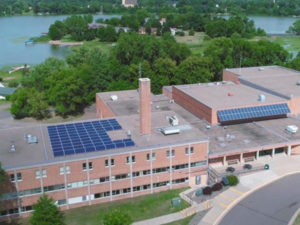Establish Benchmarking Standards
Other cities have successfully implemented building benchmarking programs that help property owners track energy consumption in their buildings, share standards and make comparisons between peers, and set goals for energy and emissions savings. Benchmarking programs calculate greenhouse gas emissions and energy use intensity, a metric that calculates a building’s energy use to a building’s size and allows for standardized comparison between buildings. This information educates building owners and can be a tool to incentivize investments in energy efficiency.
Benchmarking programs are most successful when information is transparent and accessible to building tenants, government agencies, and the general public. This transparency adds market and public pressure to make energy efficiency improvements and allows building owners and tenants to be held accountable to their greenhouse gas emission contributions.
Benchmarking has already been instituted in municipal buildings throughout Minnesota through B3 Benchmarking. Cities and municipalities submit data on over 9,000 schools, county buildings, and more, data that is collected and compared between other similar buildings and cities. Duluth has 35 public buildings that are tracked and is meeting the expected energy use benchmark. However, it ranked 210th of the 270 cities surveyed, demonstrating a lot of room for improvement and energy savings.
A number of benchmarking programs for private buildings have been instituted in Minnesotan cities, including Minneapolis and St. Paul and other smaller cities like Rochester and Edina. In the first three years of the Minneapolis benchmarking program, participating buildings saw an average 5.5% drop in energy use intensity.
Resources:
Did you take this action? Report it!
Help us show our collective community impact by reporting that you took this action.




